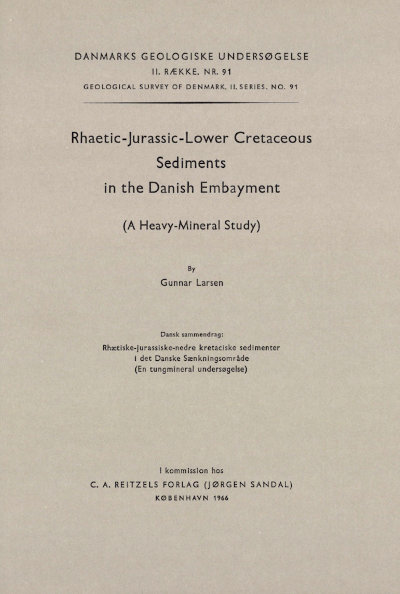Rhaetic-Jurassic-Lower Cretaceous Sediments in the Danish Embayment (A Heavy-Mineral Study)
DOI:
https://doi.org/10.34194/raekke2.v91.6882Abstract
The Danish Embayment is a major structural feature in the deeper part of the Danish underground (map, fig. 1). The subject of this study is the Rhaetic, Jurassic and Lower Cretaceous sediments in deep borings in this area. The object of the investigation has been to throw light on the origin of these sediments; the study deals with the lithology and petrography of the beds, and in particular the heavy mineral distribution.
For each boring the observations and analyses have been compiled in the form of a profile diagram (Plates II-XVII); the lithology is shown by means of a columnar section accompanied by descriptions and Schlumberger curves; the analytical data for carbonate content, grain size distribution and also the quantitative mineral distribution in the grain size fraction 75-250 μ are shown alongside.
The Rhaetic, Jurassic and Lower Cretaceous sequence is up to ca. 2 km thick. It consists essentially of rather dark marine clay deposits alternating with lighter, partly non-marine sand deposits. A simplified representation of the distribution of the two main facies in the well section (fig. 3) forms the basis of an account in which the lithological development of the sequence is reviewed. In this account the sequence is subdivided into 11 stratigraphical formations (Table I).
The account of the mineral content of the sediments starts with comments on the various minerals and mineral groups, after which the main features in the mineral distribution are described. In the area examined certain regions can be distinguished whose mineral assemblage does indeed vary upwards through the sequence, but which nevertheless retain their individuality on the whole. The reason for this regional development is discussed. The major differences from region to region are probably due to the sedimentary material having been brought from various areas of denudation; the sediments are evidently mainly derived from Fennoscandia, but the Ringkobing-Fyn High is also considered to have supplied material. Some of the marked changes in the mineral assemblage are, however, interpreted as being the result of more intense weathering and redeposition of sediments determined by alterations in the palaeogeography of the area. A third controlling factor is diagenesis, which in a few special cases seems to have altered the original mineral assemblage radically.
Finally, the results of the lithological and petrographical investigations are considered collectively in a review of the geological development of the depositional area. This account, which is introduced with comments on the structure of the basin and its relations to the surrounding area, is based on five palaeogeographical maps where the extent of the depositional area, the distribution of the clay and sand facies, and the main features of the heavy-mineral distribution are sketched for the Rhaetic, Lias, Dogger, Malm and Lower Cretaceous respectively. It emerges that considerable changes have taken place in the palaeogeography of the area from time to time. Despite this a certain uniformity can be traced in the sedimentological-palaeogeographical development in the Danish Embayment from the Rhaetic to the close of the Lower Cretaceous; it was first when the widespread Albian marine transgression took place that fundamental changes occurred.
Downloads
Published
Issue
Section
License
This article is distributed under a CC-BY 4.0 licence, permitting free redistribution and reproduction for any purpose, even commercial, provided proper citation of the original work. Author(s) retain copyright over the article contents.


